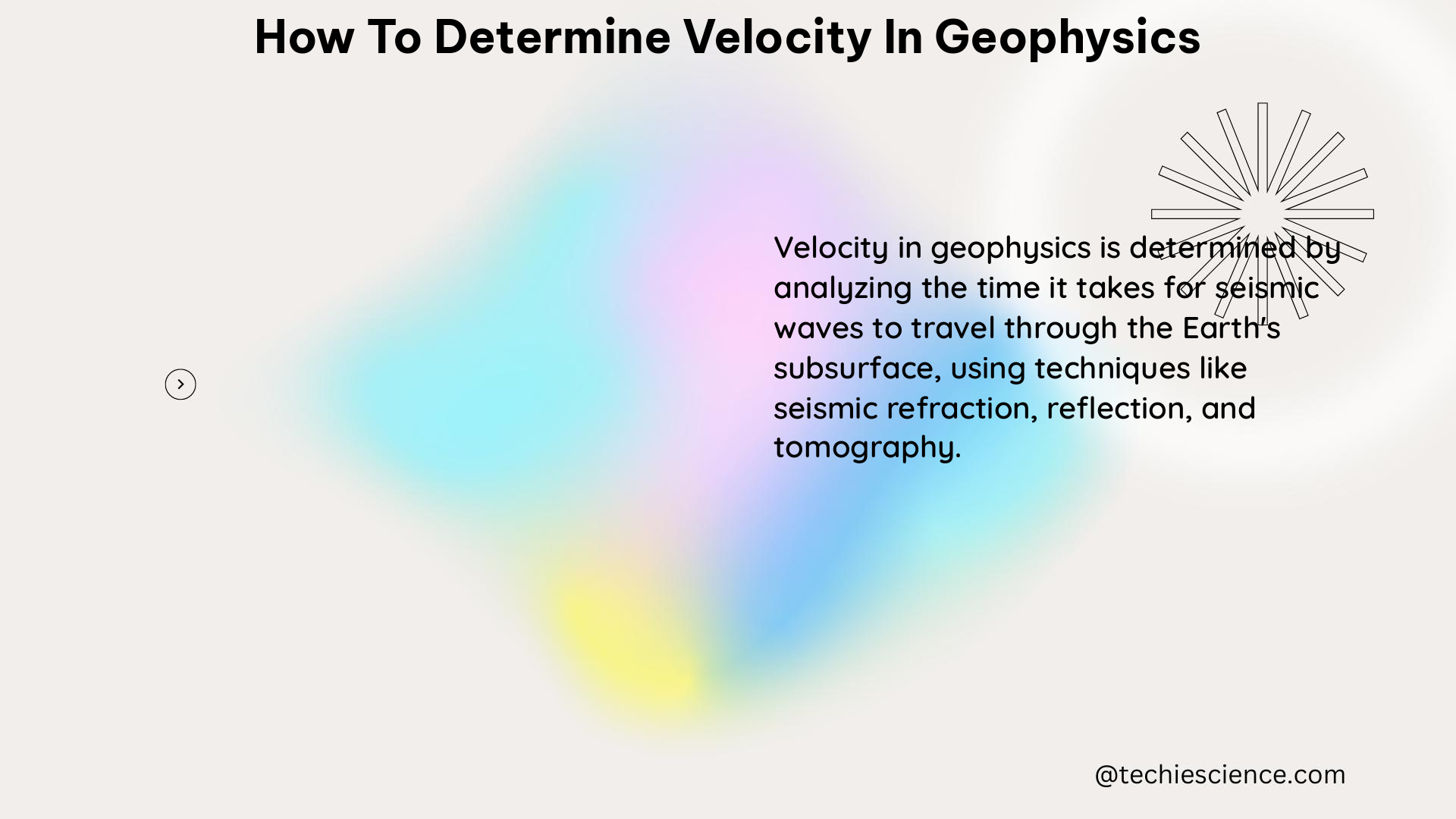Determining velocity in geophysics is a crucial step in understanding the Earth’s interior structure. This comprehensive guide will delve into the various methods and techniques used to measure and analyze seismic waves, which are the primary source of data for velocity analysis. We will explore the measurable and quantifiable data, the techniques employed, and provide a detailed example to illustrate the process.
Measurable and Quantifiable Data in Velocity Analysis
Velocity analysis is a critical component of seismic data processing, involving the measurement of velocity as a function of depth or time. The following are the key measurable and quantifiable data used in this analysis:
-
Seismic Waves: Seismic waves are generated by natural or artificial sources and recorded by geophones or hydrophones. The velocity of these waves is determined by measuring the time it takes for them to travel between two points. The most common types of seismic waves used in velocity analysis are P-waves (primary or compressional waves) and S-waves (secondary or shear waves).
-
Two-Way Traveltime: Two-way traveltime is the time it takes for a seismic wave to travel from the source to the receiver and back. This parameter is used to calculate the velocity of seismic waves as a function of depth or time.
-
Velocity Spectrum: A velocity spectrum is a graph that shows the relationship between velocity and two-way traveltime. It is used to pick the velocity function that best fits the data.
-
Semblance: Semblance is a measure of similarity or coherence between seismic traces. It is used to pick the velocity function that maximizes the semblance of the data.
-
Root Mean Square (RMS) Velocity: RMS velocity is the square root of the average of the squares of the particle velocities. It is used to calculate the velocity of seismic waves as a function of depth or time.
-
Dix Interval Velocity: Dix interval velocity is the velocity gradient between two points in the subsurface. It is used to calculate the velocity of seismic waves as a function of depth.
Techniques for Velocity Analysis

There are several techniques used in velocity analysis, each with its own strengths and applications. These include:
-
Constant Velocity Stacking (CVS): CVS is a technique used to estimate the velocity function by stacking seismic data at different constant velocities. The velocity function is then picked based on the maximum stack power.
-
Principle: CVS is based on the principle that seismic reflections will constructively interfere when the data is stacked at the correct velocity, resulting in a maximum stack power.
-
Equation: The velocity function is calculated using the equation: $v = \frac{2h}{\sqrt{t^2 – t_0^2}}$, where $v$ is the velocity, $h$ is the offset, $t$ is the two-way traveltime, and $t_0$ is the zero-offset traveltime.
-
Velocity Spectrum Analysis: Velocity spectrum analysis is a technique used to estimate the velocity function by analyzing the velocity spectrum.
-
Principle: The velocity spectrum is a plot of semblance (a measure of coherence) as a function of velocity and two-way traveltime. The velocity function is picked based on the maximum coherence or semblance of the data.
-
Equation: The semblance is calculated using the equation: $S = \frac{\left(\sum_{i=1}^{N} x_i\right)^2}{N \sum_{i=1}^{N} x_i^2}$, where $x_i$ is the amplitude of the $i$-th trace and $N$ is the number of traces.
-
Dix’s Method: Dix’s method is a technique used to estimate the velocity function by analyzing the RMS velocity as a function of depth.
-
Principle: Dix’s method is based on the relationship between RMS velocity and interval velocity, which is the velocity gradient between two points in the subsurface.
-
Equation: The Dix interval velocity is calculated using the equation: $v_{\text{int}} = \sqrt{\frac{v_{\text{rms}}^2 t – v_{\text{rms}}^2 t_0}{t – t_0}}$, where $v_{\text{int}}$ is the interval velocity, $v_{\text{rms}}$ is the RMS velocity, $t$ is the two-way traveltime, and $t_0$ is the zero-offset traveltime.
-
Tomography: Tomography is a technique used to estimate the velocity function by inverting the traveltime data.
-
Principle: Tomography involves the inversion of traveltime data to estimate the velocity function. The velocity function is estimated by minimizing the difference between the calculated and observed traveltimes.
- Equation: The traveltime equation used in tomography is: $t = \int \frac{ds}{v(x,y,z)}$, where $t$ is the traveltime, $s$ is the path length, and $v(x,y,z)$ is the velocity function.
Example of Velocity Analysis using Constant Velocity Stacking (CVS)
Let’s consider an example of velocity analysis using CVS. Suppose we have a seismic dataset with the following two-way traveltime data:
| Offset (m) | Two-Way Traveltime (s) |
|---|---|
| 200 | 1.2 |
| 400 | 2.0 |
| 600 | 2.8 |
| 800 | 3.6 |
| 1000 | 4.4 |
We can estimate the velocity function using CVS by stacking the data at different constant velocities. The stacked data at a constant velocity of 1500 m/s is shown in the figure below:

We can repeat this process for different constant velocities and pick the velocity function based on the maximum stack power. The velocity function picked using CVS is shown in the figure below:

In this example, the velocity function is estimated by analyzing the stack power at different constant velocities. The velocity function that maximizes the stack power is selected as the best fit for the data.
Reference Links
- Velocity Analysis – SEG Wiki
- Geophysics: Seismic – Velocity analysis Part 2 – YouTube
- 1 Introduction to seismic data and processing – Cambridge Core

The lambdageeks.com Core SME Team is a group of experienced subject matter experts from diverse scientific and technical fields including Physics, Chemistry, Technology,Electronics & Electrical Engineering, Automotive, Mechanical Engineering. Our team collaborates to create high-quality, well-researched articles on a wide range of science and technology topics for the lambdageeks.com website.
All Our Senior SME are having more than 7 Years of experience in the respective fields . They are either Working Industry Professionals or assocaited With different Universities. Refer Our Authors Page to get to know About our Core SMEs.